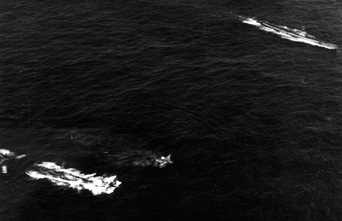|
U.S. Naval Aviation In the South Pacific during WW II Featuring the Lexington Aircraft Carrier The Battle of the Marianas — June 1944 Chapter 2 Page 2 of 5 Pages |
|||||||||||||||
| In August, 1943, we went through the Panama Canal and out to Hawaii. September, 1943 our fighter pilots were on reserve to cover an attack on Wake Island. September 18, we attacked Tarawa, in the Gilbert Islands, and made a reconnaissance report for the Marines to land and take the island from the Japanese. Tarawa was the first landing to take back an island from the Japanese and it was tough. Some 3,500 marines were casualties taking this island. Our fighter squadron caught 23 Japanese planes going to attack the marines on Tarawa and shot 19 out of the air. Victories like this went on as we attacked Kwajalein Atoll, Marshall Islands, Wake Island, Palau, Hollandia, New Guinea, Saipan, Tinian, Guam and Truk.
When we bombed Kwajalein we caught a cruiser at anchor and strafed and bombed it. |
|||||||||||||||
 |
|||||||||||||||
|
|
|||||||||||||||
 |
|||||||||||||||
|
raiders at Kwajalein is burning. Both were hit. Bright flame aft may be only a signal light. This photo was taken by McLellan’s Torpedo Bomber crew at point of torpedo release. Below: “A dive bomber’s paradise and a Japanaese hell” was a pilot’s description of December 4, 1943 raid on Kwajalein. A cargo ship is burning. |
|||||||||||||||
 |
|||||||||||||||
| On the attack on Palau Island, on a glide bombing run, my plane was hit in the engine as I dropped my bombs. I was able to get halfway back to the carrier but was advised by those flying wing on me to land before the engine quit or caught fire. I have a picture taken from a rescue plane showing my landing in the water. The picture shows a rescue submarine in the upper right comer and a rescue plane landing to pick up my crew and me. We were back in the air in 10 minutes and on our way back to the USS Wichita. It took another week before they transferred me back to the Lexington. |
|||||||||||||||
 |
|||||||||||||||
|
Ready to go to work Photo ctsy. W. McLellan coll. |
|||||||||||||||
 |
|||||||||||||||
 |
|||||||||||||||
|
Left: McLellan crew makes water landing with engine failure imminent. The splash of the touchdown on the water is seen on the right, the rescue submarine is on the left. Above: Rescue Submarine on guard, above right. Torpedo Bomber visible floating in water. Rescue SOC Seaplane, lower left, picking up crew. |
|||||||||||||||
 |
|||||||||||||||
 |
|||||||||||||||
 |
|||||||||||||||
|
seaplane in a rescue mission in another battle. Above: Rescue pilot, Mike Spinelli (center), fellow crew member “Izzy” Zautner (left), and Warren McLellan aboard USS Wichita, March 30, 1944. Left: McLellan’s two rescued crew members, John “Hutch” Hutchinson (L) and Selbie Greenhalgh, with rescue pilot, Jim Alcock (C) |
|||||||||||||||
| My airplane had bullet holes 6 out of the first 10 raids I made. Something just told me this was going to be a long war!
The big events, for me, came in June, 1944. The Saipan, Tinian and Guam assaults began. The marines and army landed on Saipan. They were having a difficult time. The Japanese fleet left the Philippine Islands for the first time since their earlier defeat at Midway Island. June 18 we learned their plan was to send their planes over our carriers and on to Guam to refuel. They planned to stay out of our range. Our radar spotted many Japanese planes coming in. They were 130 miles away. Our fighters met them about 60 miles from our carriers and shot down 402 Japanese planes before the day was over. We lost maybe 10 airplanes but we did not really know where the Japanese aircraft carriers were. |
|||||||||||||||
| Scout planes found the Japanese carriers about 4 p.m. the next day, June 19, 1944. They were 250 miles away. That was our safe limit of gasoline. About 120 airplanes took off. I navigated for 325 miles and still had the attack to make when Japanese zeroes came up under us out of the clouds. The time of day was about 7 p.m. I had seen the largest carrier hit with bombs two or three times. The air was full of smoke - all colors - red, blue, white, black. [Click here for a view of the Attack Map layout with a quick return to this page.] |
|||||||||||||||
 |
|||||||||||||||
|
Ctsy: Life Mag., dated 6/17/44 |
|||||||||||||||
| I did not know the Zeroes were there until I felt the bullets hitting my plane and heard the machine guns. Fire, smoke and hydraulic fluid filled the cockpit. I had to bail out. I had no communications but everyone in formation saw it happen. We were 11,000 feet above the Japanese Fleet and a long, long way from home and from the Lexington. Chapter 2— End of Page 2 of 5 Pages — Go to Page 3 Or This Story’s Cover Page — Editor’s Introduction — Table of Contents Fred Gwynn’s “Torpedo 16” — Chapter — 1 — 2 — 3 — 4 Or Home - Contact Us - Cold War Hist. - 91st SRS Hist. - Stardust 40 Mission Story |
|||||||||||||||